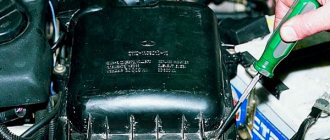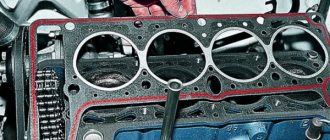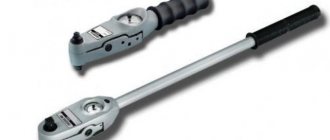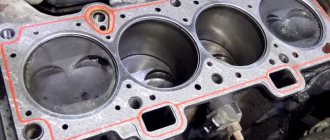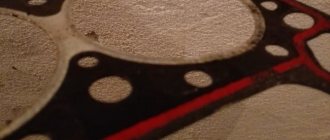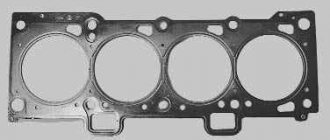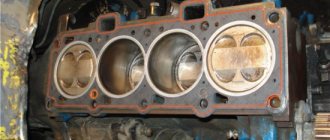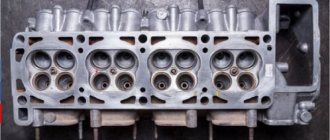When is it time to change?
The gasket serves to seal the connection between the head and the cylinder block. There are several types of it:
- Asbestos. The main advantage: minimal shrinkage and excellent recoverability.
- Metal. These are some of the most reliable and high-quality consumables.
New metal cylinder head gasket
- Non-asbestos. Used as repair kits. Main advantages: elasticity, heat resistance, elasticity.
The procedure for replacing the cylinder head gasket on a VAZ 2112 16 valves is indicated in the manual, but this is not the main reason. There are a number of signs that determine the need for replacement:
- leakage of engine oil or antifreeze in the connection area;
- white steam present in the exhaust gases indicates that antifreeze has entered the cylinders;
- when exhaust gases enter the cooling system, foam appears at the neck of the expansion tank;
- the presence of oil stains in the coolant indicates a leak in the connection;
- the presence of a white coating on the oil dipstick indicates that there is antifreeze in the engine oil; this may be due to a damaged gasket.
Replacement intervals for the cylinder head gasket on the VAZ-2110
It is very difficult to predict the exact service life of a gasket.
The most important thing that interests owners is the replacement interval for this part.
It is very difficult to say how long a particular gasket will last.
It depends on the:
- Manufacturer of the part.
- The quality of the material from which the gasket is made.
- The conditions under which these parts were stored.
Since the gasket is made of rubber, storage conditions directly affect its service life. For example, a part purchased at the market, which was stored for a long time in a damp and unheated container, will be worse than the same spare part purchased in a store.
The main function is to ensure maximum sealing of the cylinder block with the cylinder head. If you do not monitor the condition, the engine life will be significantly reduced.
conclusions
Replacing the head gasket on a VAZ-2114 is quite difficult, since you need to know the design features of this engine, as well as have experience in performing such operations on similar engines.
The choice of gasket should be approached seriously and carefully, since the normal operation of many components depends on its condition. If the process described in the article seems quite complicated and the motorist is not able to carry out the operation on his own, then it is recommended to contact a car service center, where they will help and do everything quickly and efficiently.
Signs of a broken gasket
Foam around the expansion tank cap is one of the signs of a cylinder head gasket failure.
You can find out that the seal of the connection is broken for the following reasons:
- White vapor appears in the exhaust gases.
- You may notice oil stains in the antifreeze.
- Leak in cylinder head connections.
- There is a large amount of oil in the pan.
- You may notice foam around the filler cap.
Although it seems that it is very difficult to notice the vapors in antifreeze, this can be done by placing a bag over the neck of the open expansion tank. If there are gases in the antifreeze, the bag will inflate.
Removing the valve covers on engine 21120 (16v 1.5)
Briefly, the sequence looks like this: remove the filter box and the plastic trim, disconnect the wires and unscrew the ignition module. The key must be turned to position “0”.
Removing the air filter box
To remove the filter, loosen clamps 1 and 2, and then disconnect connector 3. Pipes 1 and 2 are removed from the box. Use a 10mm wrench to unscrew the screw on the body, then remove the box from its mountings.
To disconnect high-voltage cables, you need to pull the caps out of the wells. The cables are also disconnected from the ignition module. It is pressed to the valve cover with three 10mm nuts.
We figured out the ignition module
Don't forget to disconnect the low-voltage connector and dismantle the module. If you do not unscrew the module, you will not be able to remove the valve cover on a VAZ-2112.
The part called “receiver”
First of all, you need to remove the throttle assembly: unscrew the cap on the antifreeze tank, disconnect the TPS and IAC connectors, unscrew the two fastening nuts (wrench “13”). It is also advisable to disconnect the negative terminal from the battery.
What to do before removing the receiver
Using a 10mm wrench, unscrew the cable mounting bracket from the receiver. All that remains is to remove the throttle assembly: the operation is carried out so that the assembly remains above the expansion tank. The assembly itself is finally attached to the body partition.
Articles
The gasket costs pennies compared to the labor of replacing it.
Before you start replacing the gasket, you should purchase this gasket. Although any car store will select a suitable spare part for you, it is better to know its part number. The most suitable gaskets for the VAZ-2110 are:
- The original VATI gasket, which has the article number 21083100302020.
- Part VICTOR REINZ. This item is of higher quality than the original. Its article number is 613666000.
- TRIALLI gaskets, which have the article number GZ.
It’s better to immediately buy a better quality spare part than to bother with disassembly again later.
When is it time to change?
Even an experienced specialist will not give you the answer to this question. This is because when certain elements fail, the cylinder head of an 8 or 16 valve engine is repaired, rather than replaced.
The only reason for replacing the head can only be its deformation, which does not allow the unit to be adjusted correctly.
In addition, these may be cracks that, for one reason or another, cannot be eliminated. In all other cases, the unit is repaired.
Cylinder head of VAZ 2110 disassembled
Tools
It is better to change the gasket in the garage.
Although this part can be replaced right near the house, it is better to carry out all replacement operations in the inspection hole. To replace you will need the following tools:
- Set of sockets for ratchet. Heads must be from 10 to 19;
- Torx key;
- Several screwdrivers;
- Candle key;
- Torque wrench.
A special liquid, WD-40, will also come in handy, which will help when unscrewing soured bolts. As the practice of such repairs shows, during disassembly it is often necessary to use other tools, so having them will never hurt.
Preparatory stage
Before replacement, you should place the car in an inspection hole and completely turn off the on-board power supply. After this, you will need to unscrew the crankcase protective elements in order to drain the oil from there.
It is important to remember that such operations can only be carried out on a cooled engine in order to avoid the risk of injury when replacing valves on a VAZ-2112
Dismantling the cylinder head
Removing the cylinder head
On the VAZ-2112 engine, it is highly recommended to carry out preliminary dismantling of the cylinder head. In this case, the valve guides can, in principle, not be touched, but in this case it will be necessary to dismantle various equipment, namely:
- disconnect the connector under the fuel pump hatch so that it stops pumping;
- start the engine and wait until it stalls;
- remove the air filter by loosening the clamps and disconnecting the connector, as well as unscrewing the screw with a “10” wrench.
Chemicals for cleaning
The bearing housing in the VAZ-2112 fits tightly to the cylinder head cover, and the connection between these two elements must remain sealed for normal operation of the vehicle. To maintain the desired properties, Loctite-574, KLT-75M or other similar sealants should be applied to the edge of the housing.
In principle, the cylinder head gasket does not necessarily need to be lubricated during the replacement process, since applying grease or graphite can ultimately lead, on the contrary, only to unpleasant consequences. There are VAZ-2112 owners who prefer to use graphite lubricant to treat valve stems, but this should not be done either, since this procedure is carried out exclusively with engine oil.
Valve replacement and seat repair
Valve fixing plate
Replacing valves on a VAZ-2112 (16 valves) is not as complicated a procedure as many people imagine it to be. All you have to do is do everything according to the instructions:
- All components of the cylinder head are removed and the wires are disconnected.
- The cylinder head cover is removed.
- All carbon deposits are completely removed from the cylinders. To simplify this procedure, you can use a special brush attached to a drill.
- All valves are loosened and removed with tweezers. To do this you will need to tighten the spring.
- Special diamond chips are applied to the edge of each valve.
- The valve is installed back in its place.
- The cylinder head is being assembled.
In most cases, car owners have problems treating the edge of the valve with special chips. This procedure is carried out as follows:
- a rubber pipe is threaded onto the guide valve;
- the part is scrolled until a uniform mark is visible on its edge;
- All remnants of lapping paste are carefully removed.
If after performing this operation it was not possible to achieve the desired result, you should replace the used valve with a new spare part.
If, after dismantling the VAZ-2112 valves, you see that a large amount of carbon has accumulated in the channels, before replacing it, you should completely remove it from there using a special sanding felt or a flat screwdriver.
You can see the master’s work more clearly in this video:
Replacing valve stem seals
Ideally, the valve stem seals should be changed after dismantling the cylinder head, but in practice, not every car owner will be able to implement such conditions. It should be understood that this procedure is quite lengthy and takes a lot of time, which should be prepared in advance.
The procedure itself is carried out like this:
- The negative terminal is removed from the battery.
- High voltage wires are disconnected.
- The candles are unscrewed.
- The first piston is clamped in order to prevent confusion in the valve timing.
- The valve cover is removed.
- Various wires going to the pads are disconnected.
- The mounting screws are unscrewed, after which the ignition coil is removed.
- The throttle is removed. Many people simplify this procedure, preferring to dismantle only the drive cable. If the entire throttle assembly is removed, it should be examined for contamination, since in most cases it is also cleaned in parallel with the repair.
- The screws are unscrewed, after which the fixing hose of the power steering is moved to the side.
- The mounting screws are unscrewed and the valve cover is removed.
- The mounting screws of the rocker arms are unscrewed, after which they are removed from the structure.
- “Desiccation” is performed.
- The caps are being repressed.
- The structure is carefully assembled in the reverse order.
Replacement procedure
The replacement process occurs as follows:
- First you need to disconnect the battery; to do this, remove the negative terminal.
- You need to disconnect the exhaust pipe from the muffler.
Unscrew the 4 nuts securing the muffler to the exhaust manifold.
- We dismantle the carburetor.
- Next, you need to disconnect all the sensor terminals, and all the wires are disconnected from the spark plugs.
- The next step is to disconnect the vacuum booster from the intake manifold.
- The distributor sensor is disconnected.
- Disconnect the high-voltage wires.
- Unscrew the nuts and remove the sensor.
- The fuel pump and the housing of auxiliary devices are dismantled.
Having disconnected the hoses, unscrew the nuts securing the fuel pump and remove it.
The roller and timing belt are removed.
Before this, we install the first cylinder at TDC and lock the crankshaft flywheel with a toothed lock.
- The pulley is dismantled, after which you need to remove the timing cover.
- Disconnect the hoses and unscrew the cover nuts.
After this, all that remains is to unscrew the bolts and remove the block head. After removing the old gasket, you need to carefully inspect the contact surfaces of the head and cylinder block. There should be no dirt or residue from the old gasket on them. All obvious signs of contamination must be eliminated.
Cylinder block with old gasket.
Cylinder block with old gasket.
In what cases is it necessary to tighten the block?
It becomes necessary to tighten the bolts if the cylinder head was removed to change the gasket or repair some components. Also, some car owners recommend tightening after a certain period of operation of the car or after a certain mileage of the VAZ 2110. It is important to know that before installing the head it is always recommended to install a new gasket.
Reinstalling an old one, even if it is in good condition, may not give the desired result. A new gasket is inexpensive and for VAZ 2110 cars they are sold in almost all car stores. You also need to know that the bolts that secure the cylinder head wear out over time and, under constant stress, can even stretch to some extent. Re-installation of bolts is permissible, but only when their length is no more than 9.5 centimeters.
The length should not exceed 9.5 centimeters
They are also free from damage and rust. But since they are inexpensive, it is better not to skimp and purchase a new set of bolts.
Installing a new part
The new part to be installed must be undamaged, dry and clean.
When installing, you need to make sure that the hole intended for the passage of oil is located between the third and fourth cylinders.
Before installing the cylinder head, be sure to ensure that the valves of the first cylinder are closed. The bolts must be tightened according to a certain pattern, in four stages.
Tightening sequence for cylinder head bolts.
Head milling
There are several cylinder head malfunctions that you cannot fix on your own. When the engine overheats systematically, the aluminum cylinder head becomes deformed. The perfectly flat surface of contact between the head and the engine block ceases to be so.
This leads to the gasket between the block and the head starting to leak. Replacing it with a new one does not solve the problem. In this case, grinding the adjacent surface may be the solution. Milling is performed on a special machine, which allows the work to be completed with perfect precision.
In the conditions of your garage, it is unlikely to carry out such a procedure yourself. Using a hand sander (as some garage “kulibins” advise) for this purpose means completely ruining the adjacent surface. In this case, repairing the cylinder head will lead to a complete replacement of the head - it is impossible to grind it indefinitely.


